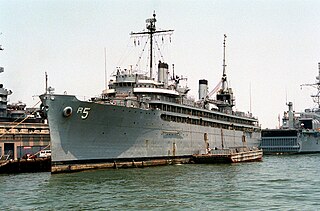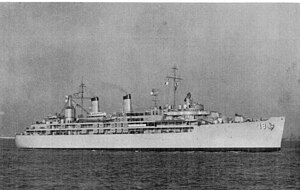
USS Shangri-La (CV/CVA/CVS-38) was one of 24 Essex-class aircraft carriers completed during or shortly after World War II for the United States Navy.

USS Topeka (CL-67), a Cleveland-class light cruiser in service with the United States Navy from 1944 to 1949. From 1957 to 1960, she was converted to a Providence-class guided missile cruiser and redesignated CLG-8. The cruiser served again from 1960 to 1969 and was finally scrapped in 1975.

USS Williamson (DD-244/AVP-15/AVD-2/APD-27) was a Clemson-class destroyer in the United States Navy during World War II. She was named for Commander William Price Williamson.

USS Allen M. Sumner (DD-692), was the lead ship of her class of destroyers. The ship was named for Allen Melancthon Sumner, a United States Marine Corps captain, who was killed in action during World War I.

USS Warrington (DD-843) was a Gearing-class destroyer that served the U.S. Navy from the end of World War II to the Vietnam War, when she was damaged by two underwater explosions, causing her to be listed as "beyond repair" and excessed to the Navy of the Republic of China.

USS Cascade (AD-16), the only ship of its class, was a destroyer tender in the United States Navy.

USS Zellars (DD-777), was an Allen M. Sumner-class destroyer that served in the United States Navy.

USS William R. Rush (DD/DDR-714) was a Gearing-class destroyer in the United States Navy. She was named for William R. Rush.

USS Voge (FF-1047), a Garcia-class frigate of the United States Navy, was named after Rear Admiral Richard George Voge. It fulfilled a Protection of Shipping (POS) mission as anti-submarine warfare (ASW) combatants for amphibious expeditionary forces, underway replenishment groups and merchant convoys. It made notable contributions to submarine 'hold-down' tactics with sister ship Koelsch. In 1976, Soviet Echo II-class submarine K-22 collided with the Voge.

USS Grand Canyon (AD-28) was a Shenandoah-class destroyer tender built at the tail end of World War II, and named for the Grand Canyon on the Colorado River.

USS Turner (DD/DDR-834) was a Gearing-class destroyer of the United States Navy, the third Navy ship named for Captain Daniel Turner (1794?–1850).

The third USS William C. Lawe (DD-763) was a Gearing-class destroyer of the United States Navy.

USS Basilone (DD/DDE-824) was a Gearing-class destroyer of the United States Navy, named for Gunnery Sergeant John Basilone (1916–1945), who was awarded the Medal of Honor for "extraordinary heroism and conspicuous gallantry in action...." in the defense of Henderson Field during the 1942 Guadalcanal campaign.

USS William H. Standley (DLG/CG-32) was a Belknap-class destroyer leader / cruiser. She was named for Admiral William Harrison Standley, former Chief of Naval Operations and ambassador to the Soviet Union. She was launched as DLG-32, a frigate, and reclassified Cruiser on 30 June 1975.

USS Arcadia was one of four Klondike-class destroyer tenders built at the tail end of World War II for the United States Navy, and the third U.S. Naval vessel to bear that name. Destroyer tenders were typically named after U.S. National Parks. However the destroyer tender AD-23 was apparently misnamed Arcadia in an effort to commemorate Acadia National Park in Maine.

USS Yellowstone was a Shenandoah-class destroyer tender named for Yellowstone National Park, the second United States Navy vessel to bear the name.

USS Tidewater (AD-31) was a Shenandoah-class destroyer tender in service with the United States Navy from 1946 to 1971. She was transferred to the Indonesian Navy as KRI Dumai (652) and served until 1984, when she was scrapped.

USS Vulcan (AR-5) was the lead ship of her class of repair ships of the United States Navy. The ship was laid down on 16 December 1939 at Camden, New Jersey, by the New York Shipbuilding Corporation; launched on 14 December 1940; sponsored by Mrs. James Forrestal, wife of the Under Secretary of the Navy; and commissioned at the Philadelphia Navy Yard on 14 June 1941.

USS Sierra (AD-18) was a Dixie-class destroyer tender built just before the start of World War II for the U.S. Navy. Her task was to service destroyers in, or near, battle areas and to keep them fit for duty.





















